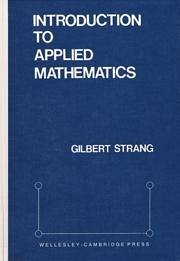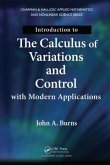Gilbert Strang
Introduction to Applied Mathematics
Gilbert Strang
Introduction to Applied Mathematics
- Gebundenes Buch
Andere Kunden interessierten sich auch für
![An Introduction to Integral Transforms An Introduction to Integral Transforms]() Baidyanath PatraAn Introduction to Integral Transforms308,99 €
Baidyanath PatraAn Introduction to Integral Transforms308,99 €![A New Introduction to the Mathematicks A New Introduction to the Mathematicks]() Benjamin DonnA New Introduction to the Mathematicks42,99 €
Benjamin DonnA New Introduction to the Mathematicks42,99 €![An Illustrated Introduction to Topology and Homotopy Solutions Manual for Part 1 Topology An Illustrated Introduction to Topology and Homotopy Solutions Manual for Part 1 Topology]() Sasho KalajdzievskiAn Illustrated Introduction to Topology and Homotopy Solutions Manual for Part 1 Topology59,99 €
Sasho KalajdzievskiAn Illustrated Introduction to Topology and Homotopy Solutions Manual for Part 1 Topology59,99 €![Elementary Introduction to the Theory of Pseudodifferential Operators Elementary Introduction to the Theory of Pseudodifferential Operators]() Xavier Saint RaymondElementary Introduction to the Theory of Pseudodifferential Operators242,99 €
Xavier Saint RaymondElementary Introduction to the Theory of Pseudodifferential Operators242,99 €![The Elementary Geology of Tennessee: Being Also an Introduction to Geology in General. Designed for the Schools of Tennessee The Elementary Geology of Tennessee: Being Also an Introduction to Geology in General. Designed for the Schools of Tennessee]() Joseph Buckner KillebrewThe Elementary Geology of Tennessee: Being Also an Introduction to Geology in General. Designed for the Schools of Tennessee36,99 €
Joseph Buckner KillebrewThe Elementary Geology of Tennessee: Being Also an Introduction to Geology in General. Designed for the Schools of Tennessee36,99 €![Introduction to the Calculus of Variations and Control with Modern Applications Introduction to the Calculus of Variations and Control with Modern Applications]() John A. BurnsIntroduction to the Calculus of Variations and Control with Modern Applications254,99 €
John A. BurnsIntroduction to the Calculus of Variations and Control with Modern Applications254,99 €![An Introduction to the Summation of Differences of a Function An Introduction to the Summation of Differences of a Function]() Benjamin Feland GroatAn Introduction to the Summation of Differences of a Function33,99 €
Benjamin Feland GroatAn Introduction to the Summation of Differences of a Function33,99 €-
-
-
Produktdetails
- Verlag: Wellesley College
- Seitenzahl: 760
- Erscheinungstermin: 1. Januar 1986
- Englisch
- Abmessung: 243mm x 172mm x 40mm
- Gewicht: 1227g
- ISBN-13: 9780961408800
- ISBN-10: 0961408804
- Artikelnr.: 24329017
Hinweis: Dieser Artikel kann nur an eine deutsche Lieferadresse ausgeliefert werden.
- Herstellerkennzeichnung
- Libri GmbH
- Europaallee 1
- 36244 Bad Hersfeld
- gpsr@libri.de
Gilbert Strang received his Ph.D. from UCLA and since then he has taught at MIT. He has been a Sloan Fellow and a Fairchild Scholar and is a Fellow of the American Academy of Arts and Sciences. He is a Professor of Mathematics at MIT and an Honorary Fellow of Balliol College. Professor Strang has published eight textbooks. He received the von Neumann Medal of the US Association for Computational Mechanics, and the Henrici Prize for applied analysis. The first Su Buchin Prize from the International Congress of Industrial and Applied Mathematics, and the Haimo Prize from the Mathematical Association of America, were awarded for his contributions to teaching around the world.
1. Symmetric Linear Systems: 1.1 Introduction
1.2 Gaussian elimination
1.3 Positive definite matrices
1.4 Minimum principles
1.5 Eigenvalues and dynamical systems
1.6 A review of matrix theory
2. Equilibrium Equations: 2.1 A framework for the applications
2.2 Constraints and Lagrange multipliers
2.3 Electrical networks
2.4 Structures in equilibrium
2.5 Least squares estimation and the Kalman filter
3. Equilibrium in the Continuous Case: 3.1 One-dimensional problems
3.2 Differential equations of equilibrium
3.3 Laplace's equation and potential flow
3.4 Vector calculus in three dimensions
3.5 Equilibrium of fluids and solids
3.6 Calculus of variations
4. Analytical Methods: 4.1 Fourier series and orthogonal expansions
4.2 Discrete Fourier series and convolution
4.3 Fourier integrals
4.4 Complex variables and conformal mapping
4.5 Complex integration
5. Numerical Methods: 5.1 Linear and nonlinear equations
5.2 Orthogonalization and eigenvalue problems
5.3 Semi-direct and iterative methods
5.4 The finite element method
5.5 The fast Fourier transform
6. Initial-Value Problems: 6.1 Ordinary differential equations
6.2 Stability and the phase plane and chaos
6.3 The Laplace transform and the z-transform
6.4 The heat equation vs. the wave equation
6.5 Difference methods for initial-value problems
6.6 Nonlinear conservation laws
7. Network Flows and Combinatorics: 7.1 Spanning trees and shortest paths
7.2 The marriage problem
7.3 Matching algorithms
7.4 Maximal flow in a network
8. Optimization: 8.1 Introduction to linear programming
8.2 The simplex method and Karmarkar's method
8.3 Duality in linear programming
8.4 Saddle points (minimax) and game theory
8.5 Nonlinear optimization
Software for scientific computing
References and acknowledgements
Solutions to selected exercises
Index.
1.2 Gaussian elimination
1.3 Positive definite matrices
1.4 Minimum principles
1.5 Eigenvalues and dynamical systems
1.6 A review of matrix theory
2. Equilibrium Equations: 2.1 A framework for the applications
2.2 Constraints and Lagrange multipliers
2.3 Electrical networks
2.4 Structures in equilibrium
2.5 Least squares estimation and the Kalman filter
3. Equilibrium in the Continuous Case: 3.1 One-dimensional problems
3.2 Differential equations of equilibrium
3.3 Laplace's equation and potential flow
3.4 Vector calculus in three dimensions
3.5 Equilibrium of fluids and solids
3.6 Calculus of variations
4. Analytical Methods: 4.1 Fourier series and orthogonal expansions
4.2 Discrete Fourier series and convolution
4.3 Fourier integrals
4.4 Complex variables and conformal mapping
4.5 Complex integration
5. Numerical Methods: 5.1 Linear and nonlinear equations
5.2 Orthogonalization and eigenvalue problems
5.3 Semi-direct and iterative methods
5.4 The finite element method
5.5 The fast Fourier transform
6. Initial-Value Problems: 6.1 Ordinary differential equations
6.2 Stability and the phase plane and chaos
6.3 The Laplace transform and the z-transform
6.4 The heat equation vs. the wave equation
6.5 Difference methods for initial-value problems
6.6 Nonlinear conservation laws
7. Network Flows and Combinatorics: 7.1 Spanning trees and shortest paths
7.2 The marriage problem
7.3 Matching algorithms
7.4 Maximal flow in a network
8. Optimization: 8.1 Introduction to linear programming
8.2 The simplex method and Karmarkar's method
8.3 Duality in linear programming
8.4 Saddle points (minimax) and game theory
8.5 Nonlinear optimization
Software for scientific computing
References and acknowledgements
Solutions to selected exercises
Index.
1. Symmetric Linear Systems: 1.1 Introduction
1.2 Gaussian elimination
1.3 Positive definite matrices
1.4 Minimum principles
1.5 Eigenvalues and dynamical systems
1.6 A review of matrix theory
2. Equilibrium Equations: 2.1 A framework for the applications
2.2 Constraints and Lagrange multipliers
2.3 Electrical networks
2.4 Structures in equilibrium
2.5 Least squares estimation and the Kalman filter
3. Equilibrium in the Continuous Case: 3.1 One-dimensional problems
3.2 Differential equations of equilibrium
3.3 Laplace's equation and potential flow
3.4 Vector calculus in three dimensions
3.5 Equilibrium of fluids and solids
3.6 Calculus of variations
4. Analytical Methods: 4.1 Fourier series and orthogonal expansions
4.2 Discrete Fourier series and convolution
4.3 Fourier integrals
4.4 Complex variables and conformal mapping
4.5 Complex integration
5. Numerical Methods: 5.1 Linear and nonlinear equations
5.2 Orthogonalization and eigenvalue problems
5.3 Semi-direct and iterative methods
5.4 The finite element method
5.5 The fast Fourier transform
6. Initial-Value Problems: 6.1 Ordinary differential equations
6.2 Stability and the phase plane and chaos
6.3 The Laplace transform and the z-transform
6.4 The heat equation vs. the wave equation
6.5 Difference methods for initial-value problems
6.6 Nonlinear conservation laws
7. Network Flows and Combinatorics: 7.1 Spanning trees and shortest paths
7.2 The marriage problem
7.3 Matching algorithms
7.4 Maximal flow in a network
8. Optimization: 8.1 Introduction to linear programming
8.2 The simplex method and Karmarkar's method
8.3 Duality in linear programming
8.4 Saddle points (minimax) and game theory
8.5 Nonlinear optimization
Software for scientific computing
References and acknowledgements
Solutions to selected exercises
Index.
1.2 Gaussian elimination
1.3 Positive definite matrices
1.4 Minimum principles
1.5 Eigenvalues and dynamical systems
1.6 A review of matrix theory
2. Equilibrium Equations: 2.1 A framework for the applications
2.2 Constraints and Lagrange multipliers
2.3 Electrical networks
2.4 Structures in equilibrium
2.5 Least squares estimation and the Kalman filter
3. Equilibrium in the Continuous Case: 3.1 One-dimensional problems
3.2 Differential equations of equilibrium
3.3 Laplace's equation and potential flow
3.4 Vector calculus in three dimensions
3.5 Equilibrium of fluids and solids
3.6 Calculus of variations
4. Analytical Methods: 4.1 Fourier series and orthogonal expansions
4.2 Discrete Fourier series and convolution
4.3 Fourier integrals
4.4 Complex variables and conformal mapping
4.5 Complex integration
5. Numerical Methods: 5.1 Linear and nonlinear equations
5.2 Orthogonalization and eigenvalue problems
5.3 Semi-direct and iterative methods
5.4 The finite element method
5.5 The fast Fourier transform
6. Initial-Value Problems: 6.1 Ordinary differential equations
6.2 Stability and the phase plane and chaos
6.3 The Laplace transform and the z-transform
6.4 The heat equation vs. the wave equation
6.5 Difference methods for initial-value problems
6.6 Nonlinear conservation laws
7. Network Flows and Combinatorics: 7.1 Spanning trees and shortest paths
7.2 The marriage problem
7.3 Matching algorithms
7.4 Maximal flow in a network
8. Optimization: 8.1 Introduction to linear programming
8.2 The simplex method and Karmarkar's method
8.3 Duality in linear programming
8.4 Saddle points (minimax) and game theory
8.5 Nonlinear optimization
Software for scientific computing
References and acknowledgements
Solutions to selected exercises
Index.








